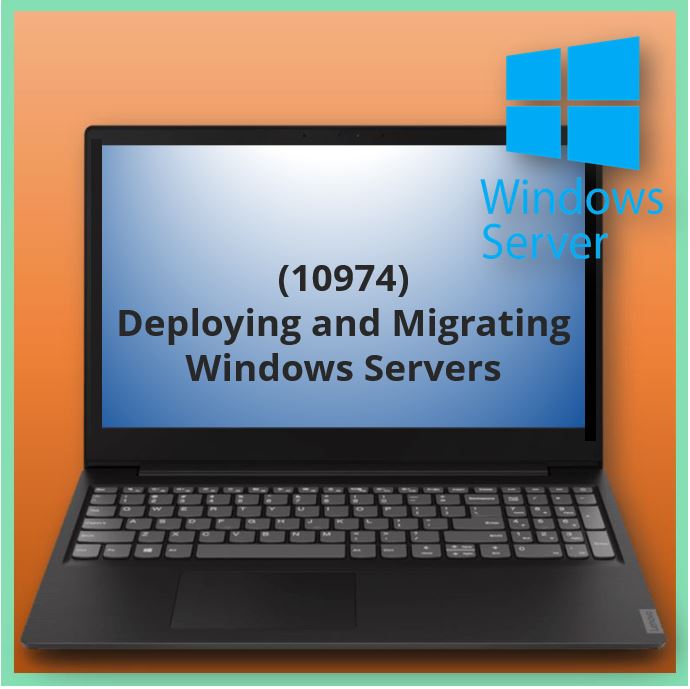Aangeboden leervormen


Deploying and Migrating Windows Servers (10974)
Inleiding
In this course, you will learn how to plan for and deploy your Windows Server infrastructure in physical, virtual, and cloud environments. You will learn about different deployment methodologies and techniques, as well as general imaging usage and configuration. You will also learn how to use Windows Deployment Services (WDS) and how to work with deployment tools such as the Windows Assessment and Deployment Toolkit (Windows ADK), the Microsoft Assessment and Planning Toolkit (MAP), and the Microsoft Deployment Toolkit (MDT). You will also learn how to plan for virtualizing server workloads and considerations around technologies available for networking and storage, as well as considerations for specific applications such as SQL, Exchange, and other application workloads.
This course also focuses on migrating essential components within your server infrastructure to Windows server 2012 and Windows Server 2012 R2. It covers the migration of core infrastructure technologies such as migrating Dynamic Host Configuration Protocol (DHCP), Domain Name System (DNS), and Active Directory Domain Services (AD DS). This course also describes in detail the migration of File and Web servers, Hyper-V, Windows Update services (WSUS), and Active Directory Certificate Services (AD CS). It also covers consideration options available for extending some of your workloads into Microsoft Azure to allow for on- and off-premise as well as hybrid deployment scenarios.
The detailed hands-on labs, and in-depth content and learning provides you the knowledge and skills to deploy and migrate your Windows Server infrastructure and its constituent components with minimal overhead and cost for one-off or large scale deployments.
At Course Completion
After completing this course, students will be able to:
· Prepare to deploy Windows Server 2012.
· Describe the various methods of deploying Windows Server 2012.
· Deploy Windows Server 2012 by using Windows Deployment Services and MDT.
· Plan to virtualize workloads in a Windows Server 2012 environment.
· Upgrade and migrate core networking services to Windows Server 2012.
· Migrate file services and Web and application servers to Windows Server 2012.
· Upgrade and migrate AD DS to Windows Server 2012.
· Implement Microsoft Azure Active Directory (Microsoft Azure AD).
Voor wie
This course is intended for experienced IT Professionals who have the following experience and background:
• IT professionals with real-world experience working in an enterprise environment where they are involved in deploying servers and the migration of server roles and services.
• IT professionals who work Windows Server 2003 or Windows Server 2008 servers and who are preparing for a Windows Server 2012 deployment.
• IT professionals who work in small to medium-sized enterprises who manage and are responsible for server deployment and migration.
• IT professionals who have skills in other areas and are looking to develop knowledge and skills with Windows Server deployments.
Programma
Module 1: Preparing to Deploy Windows Server 2012
Although you can use a number of tools and technologies to help you deploy the Windows Server 2012 operating system, it is important to understand how to plan for and perform individual server installations by using local media. This module explains how to plan for and perform individual server installations by using local media. It also describes how to configure, secure, and manage the server following installation by using remote management tools where appropriate. The module also explains how to activate your servers and manage volume activations.
Lessons
· Planning a Windows Server 2012 Implementation
· Installing Windows Server 2012
· Configuring and Managing Servers Remotely
· Implementing a Volume Licensing Strategy
Lab : Planning to Implement Windows Server 2012
· Using the Microsoft Assessment and Planning Toolkit
Lab : Configuring and Managing Server Core
· Installing Server Core (optional)
· Configuring and Managing Server Core
After completing this module, students will be able to:
· Plan Windows Server 2012 deployment.
· Install Windows Server 2012 from local media.
· Configure and manage servers remotely.
· Implement a suitable volume licensing strategy.
Module 2: Deploying Windows Server 2012
Organizations have different Windows Server installation and deployment needs. Often, the choice that organizations make about which deployment technology to use depends on the number of servers they plan to deploy. This module describes the key deployment scenarios and provides guidance about suitable Microsoft deployment technologies to facilitate them. This module also explains how to use the Windows Assessment and Deployment Kit (Windows ADK) to assist with some of these deployment scenarios and the different types of images you use in some of these scenarios. Finally, this module also provides instructions on how to perform unattended installations of Windows Server 2012.
Lessons
· Selecting a Suitable Deployment Method
· The Windows Assessment and Deployment Toolkit
· Overview of Image Files in the Deployment Process
· Working with Unattended Answer Files
Lab : Deploying Windows Server with Answer Files
· Creating an Answer File
· Using the Answer File to Launch Deployment
After completing this module, students will be able to:
· Select an appropriate deployment strategy.
· Use the Windows ADK to perform server deployment.
· Describe how to use image files in the deployment process.
· Work with unattended answer files.
Module 3: Implementing Lite-Touch Deployments
Microsoft Deployment Toolkit (MDT) 2013 forms a unifying framework for Microsoft Windows Deployment Services, the Windows Assessment and Deployment Kit (Windows ADK), and System Center 2012 Configuration Manager (Configuration Manager 2012) with documentation on best practices to help you deploy the Windows Server 2012 operating system more easily. Larger organizations need deployment technologies that can reduce or eliminate user-interaction during the deployment process. You can use Windows Deployment Services to help support both lite-touch and zero-touch, high-volume deployments. This module explores the functionality of Windows Deployment Services and explains how to use Windows Deployment Services tools to perform lite-touch deployments. It also describes how to configure MDT and perform lite-touch deployments by using MDT.
Lessons
· Overview of MDT 2013
· Implementing Windows Deployment Services to Support Lite-Touch Deployments
· Configuring Microsoft Deployment Toolkit
· Performing Lite-Touch Deployments
Lab : Implementing Lite-Touch Deployments
· Installing and Configuring MDT
· Creating and Customizing a Task Sequence
· Configuring the Deployment Share
· Performing a Lite-Touch Deployment
After completing this module, students will be able to:
· Describe the Microsoft Deployment Toolkit (MDT) 2013.
· Describe how to use Windows Deployment Services to support the lite-touch deployment of Windows Server 2012.
· Configure MDT 2013 to support your deployment strategy.
· Perform lite-touch deployments by using MDT 2013.
Module 4: Planning to Virtualize Workloads
Most organizations are looking for ways to decrease the cost and complexity of providing an information technology (IT) infrastructure. Virtualization has become a key component in developing an efficient and cost-effective IT strategy. This module introduces some of the critical planning components that you must consider when you implement virtualization.
Lessons
· Planning Server Virtualization Deployments
· Implementing Server Virtualization by Using Hyper-V
· Designing Virtual Machines
Lab : Planning to Virtualize Workloads
· Planning a Server Consolidation and Virtualization Strategy
· Evaluating Virtualization Candidates
After completing this module, students will be able to:
· Plan the deployment of server virtualization.
· Implement server virtualization by using Hyper-V.
· Design virtual machines to support application workloads.
Module 5: Upgrading and Migrating Networking Services
Servers that run network services are responsible for facilitating communication between computers on your network, and ensuring that the configuration of network infrastructure components supports a reliable network environment. The two most common network infrastructure roles on Windows Servers are the Dynamic Host Configuration Protocol (DHCP) server role and the Domain Name System (DNS) server role. Upgrading and migrating these roles is a critical first step in the migration process to ensure that the rest of your migration project can use the network infrastructure.
In Windows Server 2012, you can manage the DHCP and DNS server roles after or during migration with the new IP Address Management (IPAM) feature. IPAM enables you to centralize the management and monitoring of DHCP and DNS servers on your network.
This module will explain the tools and processes that you can use to migrate DHCP and DNS server roles, and will show you how you can use IPAM to manage and monitor your DHCP and DNS servers.
Lessons
· Migrating the DHCP Server Role
· Migrating the DNS Server Role
· Implementing IPAM
Lab : Upgrading and Migrating Network Services
· Migrating the DHCP Server Role
· Migrating the DNS Server Role
Lab : Implementing IPAM
· Deploying and Configuring IPAM
After completing this module, students will be able to:
· Migrate the DHCP server role to Windows Server 2012.
· Migrate the DNS server role to Windows Server 2012.
· Manage IP address spaces with IPAM.
Module 6: Upgrading and Migrating Server Roles
File servers and web servers are present in almost all corporate networks. You should consider the impact of these servers on your network, and how migrating to Windows Server 2012 can improve the functionality of file servers and web servers on your network. In this module, you learn about the migration considerations and the processes for migrating file servers and web servers.
Lessons
· Upgrading and Migrating File Servers
· Migrating Web and Application Servers
Lab : Migrating File Services
· Preparing to Migrate to the File and Storage Services Role
· Migrating to the File and Storage Services Role
Lab : Preparing and Migrating a Web Server
· Preparing to Migrate a Web Server
· Migrating a Web Server
After completing this module, students will be able to:
· Upgrade and migrate file servers to Windows Server 2012.
· Upgrade and migrate web and application servers to Windows Server 2012.
Module 7: Upgrading and Migrating AD DS
For most organizations, the Active Directory Domain Services (AD DS) deployment is the most important component in the IT infrastructure. Organizations deploy or migrate AD DS for a central identity and access service that provides access to many other network services in the organization. AD DS provides the primary security mechanism within most organizations, and enables policy-based management for user and computer accounts. It is critical that you follow the correct procedures for upgrading or migrating your AD DS infrastructure to ensure the continuity of your organization’s core identity and access functionality during the upgrade or migration process.
Active Directory Certificate Services (AD CS) works with AD DS to provide a public key infrastructure (PKI) that facilitates additional authentication for users and computers in your environment. Migrating AD CS to Windows Server 2012 depends on a specific process, and can provide several benefits to your PKI environment.
This module explains how to prepare for migrating AD DS in Windows Server 2012. It also explains the tools that you can use to perform the migration. It then explains how to upgrade and restructure domain controllers. Finally, it explains how to migrate AD CS.
Lessons
· Overview of Windows Server 2012 AD DS Upgrade and Migration
· Upgrading Domain Controllers to Windows Server 2012
· Restructuring an Active Directory Domain
· Migrating Active Directory Certificate Services
Lab : Upgrading AD DS to Windows Server 2012
· Deploying a Windows Server 2012 Domain Controller
· Removing Legacy Domain Controllers
Lab : Migrating AD CS
· Preparing to Migrate AD CS
· Migrating AD CS
After completing this module, students will be able to:
· Identify the key components of AD DS migration.
· Upgrade domain controllers to Windows Server 2012.
· Restructure an Active Directory domain.
· Migrate Active Directory Certificate Services (AD CS).
Module 8: Migrating to Microsoft Azure
Microsoft Azure is an open and flexible cloud-based platform that allows you to build, deploy, and manage applications within Microsoft-managed datacenters. Within Azure, Microsoft provides cloud-based services, such as Microsoft Azure Active Directory (Microsoft Azure AD). Microsoft Azure AD is an online directory service that you can use for cloud-based applications. This module explores Microsoft Azure and Microsoft Azure AD.
Lessons
· Extending Virtualization to the Cloud Environment
· Overview of Azure Active Directory
· Implementing Azure Active Directory
Lab : Implementing Azure Active Directory
· Planning to Implement Microsoft Azure AD for Office 365
· Planning to Implement Microsoft Azure AD for a Cloud-Based Application
· Implementing Azure AD
After completing this module, students will be able to:
· Describe how Microsoft Azure can help you extend virtualization into the cloud.
· Describe Microsoft Azure AD.
· Implement Microsoft Azure AD.
Voorkennis
Before attending this course, students must have:
• Knowledge and real-world experience working day to day with Windows Servers in an enterprise environment.
• Knowledge and experience with core infrastructure technologies such as DNS, DHCP, and AD DS.
• Knowledge and experience with virtualization technologies such as Hyper-V.
• Knowledge and experience with AD CS, WSUS, File, and Web servers. (This is beneficial but is not essential.)
• Some experience working with Windows Server 2012 or Windows Server 2012 R2. (This is beneficial but is not essential.)
Examen
NVT
Duur training
Klassikaal: 3 dagen
Open leercentrum: 3 dagen








